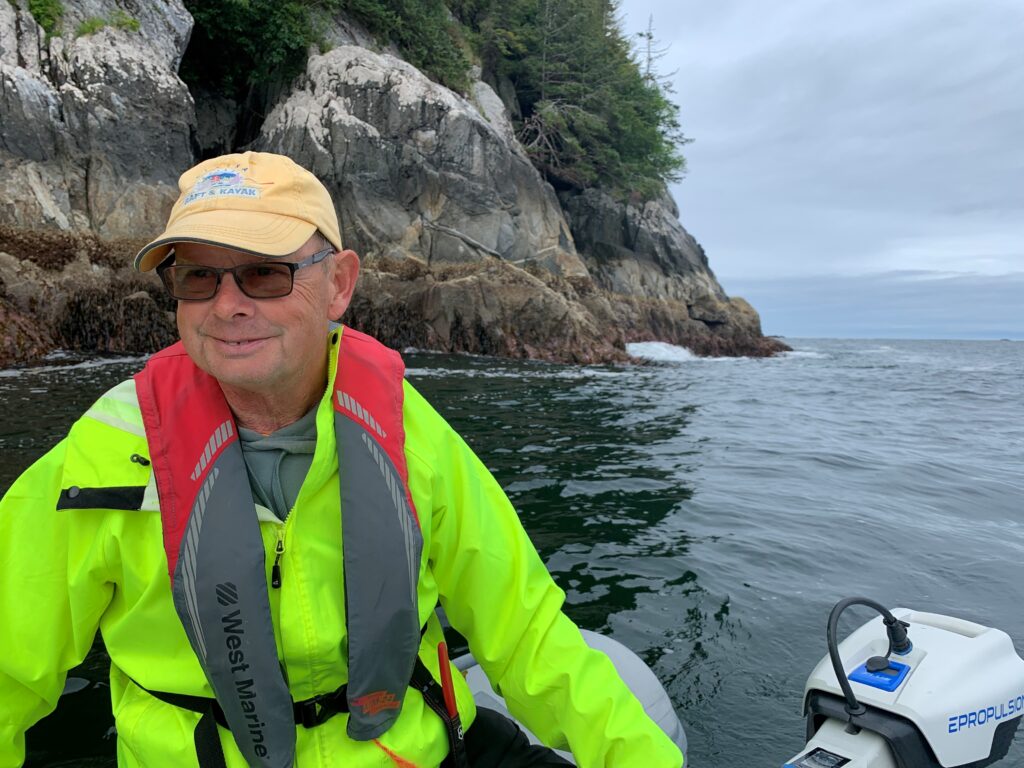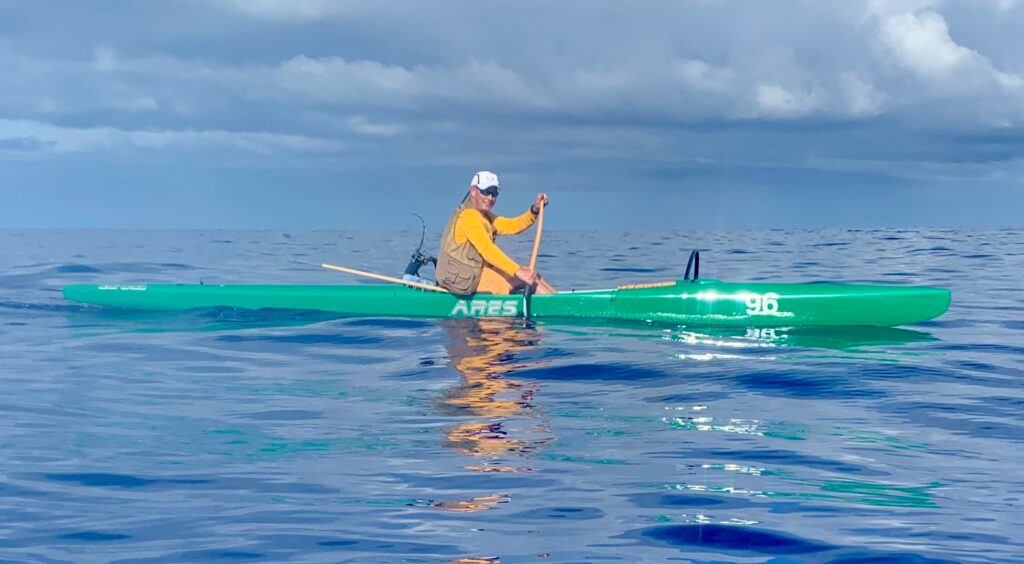Volunteer Spotlight

Growing up in western North Carolina, over 3,000 miles away from Alaska, Tim Robertson and his brothers Roy and Andy knew all about the 49th state. His dad was obsessed.
“If there was a TV show or a movie or anything about Alaska, he drug the whole family to see it,” Robertson says. All three brothers ended up moving here.
These days Tim splits his time between Alaska and Hawaii. At first glance, it might seem like the two states are very different, but Tim’s values are present in both.
“I’m a small-boat guy on big water,” he says. “There’s the same connection with the ocean. A lot of mornings I watch the sun rise from the water. It’s a big part of what I am.”
Robertson spent his first few years in Alaska working in an oil-related field, first as a research biologist for Alaska Department of Fish and Game, then for an oil field service company.
He dreamt of a different career though. Robertson acquired land in Seldovia in 1985, and partnered with another family to build Harmony Point Wilderness Lodge, an ecotourism business. They had only been in business a few short years when the Exxon Valdez ran aground.
“The first time I ever heard of ICS [Incident Command System] was when we had a community meeting after the spill,” says Robertson.
The Incident Command System is a standardized structure that is used to organize the response during all types of emergencies. It was first developed in the 1970s to manage wildfires.
Seldovia’s fire chief taught the system to the group that showed up to that meeting.
“Which was essentially every able-bodied adult in the community,” Robertson says. “At least for the first few months, that how it all came together. We used a lot of fishermen ingenuity.”
Oil spill response then wasn’t well-planned out and documented like it is today. Community members had to get creative. They built thousands of feet of oil spill boom and planned out how to protect their local shores.
“I knew the coast really well, I knew the outdoors, I knew the fishermen, I knew our community, and I was learning about tourism at the time, but I didn’t really know anything about picking up oil,” Robertson says.
“Pulling boom is really no different than pulling a net and skimming oil off the water’s not real different than sucking up fish with a trans-vac fish pump.”
Later on, Seldovia’s mayor asked Robertson if he would go to Anchorage and meet with a group who was forming a new kind of organization. He accepted. That organization was eventually named the Prince William Sound Regional Citizens’ Advisory Council.
Robertson was elected the Council’s first vice president and first chair of the Oil Spill Prevention and Response, or OSPR, Committee. He left the Council’s Board after a few years, but remained an advocate for improving oil spill prevention and response.
In the mid-1990s, Robertson traveled to Washington, D.C., to help improve the national oil spill contingency plan. He says that before the spill, most contingency plan regulations were managed by individual states. Requirements stemming from the Oil Pollution Act of 1990 led to many changes and Robertson was right in the middle of it, representing others who were affected by oil spills.
“I was pretty passionate about it because I had worked in the oil industry, and I felt somewhat responsible for producing the oil that ended up on the beaches that I loved and impacting my friends and community.”
Robertson stayed involved with the Council over the years as a contractor. He co-founded Nuka Research and Planning Group, an environmental consulting firm that has supported many of the Council’s projects.
Robertson retired in 2023. He now volunteers for the Cook Inlet Regional Citizens Advisory Council and recently re-joined the Prince William Sound Council’s OSPR Committee.
“It’s really cool to come full circle back to the Council and contribute as a volunteer. It’s been a big part of my life.”
Robertson and his fellow Seldovians’ plans to protect their shores later evolved into an official part of Alaska’s oil spill response plans. Geographic Response Strategies, or GRS, are plans that are developed for specific, unique areas that are particularly sensitive to contamination. Responders practice these from time to time.
“It’s almost impossible to deploy one and not learn something,” Robertson says. OSPR works to get such lessons incorporated into spill contingency plans.
He says that it’s important for citizens to have a say in decisions that will directly affect them.
“Continual pressure tends to swing regulation toward the industry’s favor,” he says. “We talk about risk makers and risk takers. The industry are the risk makers and people along the coast of Alaska are the risk takers.”
“That’s what RCAC does so great,” he adds. “Because they put people at the table that are reasonable and understand the policies, technologies, and science.”

More about the early days of the Council
As one of our founding Board members, in 2013, Robertson was asked to reflect on the formation and early years of the Council. Tim’s story, along with 20 other folks who were involved early on can be found in the Council’s publication Stories from a Citizens’ Council.
Nuka Research reports authored by Tim Robertson
The following are some of the reports Robertson authored or co-authored for the Council. This is not a complete list of all of Robertson’s work.
| Link to additional details | Date | Description | View Full Report |
|---|---|---|---|
| Prince William Sound Out-Of-Region Oil Spill Response Equipment Survey | September 1, 2022 | This report presents a survey of oil spill response equipment available from outside the Prince William Sound (PWS)/Gulf of Alaska region to supplement the response to an oil spill from … | |
| Geographic Response Planning for the Copper River Delta and Flats | March 1, 2022 | This report by Sierra Fletcher, Breck Tostevin, and Tim Robertson of Nuka Research documents the history of the development of geographic response strategies (GRS) for the Copper River Delta and … | |
| Alaska’s Oil Spill Response Planning Standard (Graphic Version) | November 8, 2019 | This is a graphic synopsis of the full report: ‘Alaska’s Oil Spill Response Planning Standard – History and Legislative Intent’ (PDF/5.6MB). | |
| Alaska’s Oil Spill Response Planning Standard – History And Legislative Intent | August 8, 2018 | This report tells the story of how and why an unlikely alliance of regulators, politicians, oil industry executives, and international spill response experts used the Exxon Valdez oil spill as … | |
| Prince William Sound Oil Spill Recovery Optimization Analysis | February 1, 2017 | This study analyzed potential options to increase oil recovery by optimizing both the open-water and nearshore on-water recovery systems based in Prince William Sound. | |
| Oil Simulants Workshop Proceedings | June 21, 2013 | This report summarizes a workshop of national experts to address key questions regarding the potential permitting and use of oil simulants in US waters to improve oil spill response planning … | |
| Non-mechanical Response Gap Estimate for Two Operating Areas of Prince William Sound – 2008 | April 15, 2008 | The ‘response gap’ is the window between the upper limits of the response system (in terms of environmental conditions) and the conditions at which Hinchinbrook Entrance is closed to laden … | |
| Non-mechanical Response Gap Estimate: Literature Review and Recommended Limits – 2007 | August 21, 2007 | This report analyzes the response gap that exists for non-mechanical response operations at two locations in Prince William Sound. | |
| Response Gap Estimates for Two Operating Areas in Prince William Sounds – 2007 | February 8, 2007 | In 2006, the Council commissioned a study to determine the frequency and duration of any Response Gap that exists in Prince William Sound. | |
| Response Gap Methods | May 5, 2006 | In 2006, the Council commissioned a study to determine the frequency and duration of any Response Gap that exists in Prince William Sound. |